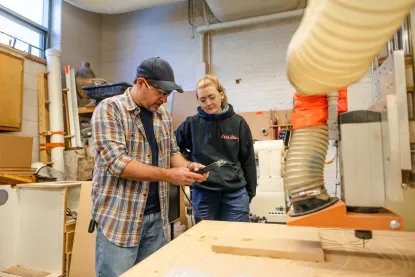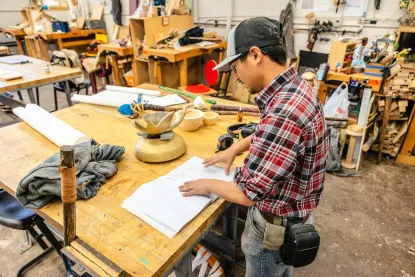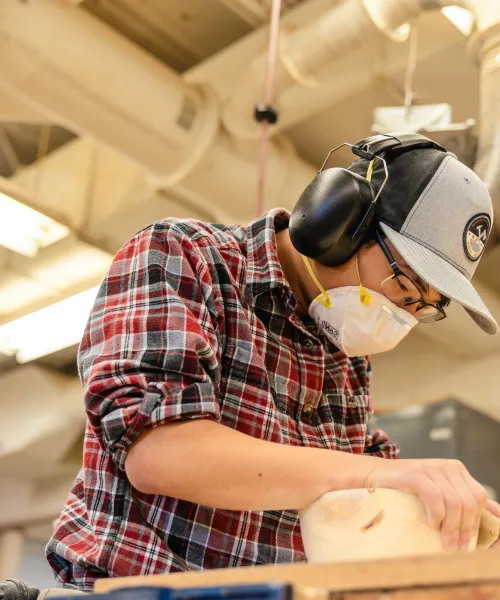Quick Links

About the Program
The School of Art and Design offers B.S., B.A., and B.F.A. degrees in Woodworking. This program teaches students to translate concepts from drawings and models into full-size, expressive pieces. For students interested in production, the curriculum also includes designing and building the necessary jigs and fixtures.
While the primary emphasis is on woodworking, students are encouraged to explore our foundry and smithing facilities. The product design track is a cross-disciplinary program, requiring courses in sculpture, ceramics, metals, and woodworking. Our teaching philosophy emphasizes creative problem-solving; we empower students to use their knowledge of media and tools to find innovative solutions rather than being limited by traditional techniques.
Woodworking & Furniture Faculty
Woodworking & Furniture Courses
ARTD 224 Woodworking: Foundations
4 credit hours
Offered: Fall, Winter
This course is an introduction to the language, tools, and techniques used in creating functional wood objects. Students will develop their personal creativity and design sensibility while broadening their technical knowledge of wood materials. We will focus on the concepts and methods of designing and building functional solid wood and plywood objects.
AD 324A Woodworking: Boxes & Cabinets
4 credit hours
Offered: Fall, even numbered years
Prerequisite: Sophomore standing or instructor permission.
Introduction to joinery techniques used in creating functional solid wood and plywood cabinetry. Emphasis is placed on the design and construction of doors, drawers, carcasses, and the use of store-bought and handmade hardware.
AD 324B Woodworking: Form, Volume, and Function
4 credit hours
Offered: Fall, odd-numbered years
Prerequisite: Sophomore standing or instructor permission.
This course is structured to give students an advanced understanding of the technical skills necessary to create volume and form when creating furniture and sculpture objects with solid wood and plywood.
AD 444 Seating Design
4 credit hours
Offered: Winter, even-numbered years
Prerequisite: ARTD 209 or ARTD 210 or AD/ARTD 222 or AD/ARTD 223 or AD/ARTD 224; or instructor permission.
This course focuses on the materials and methods of designing and building objects used for seating, including the ergonomics, aesthetics, and structural needs. Emphasis is placed on developing personal creativity and design sensibility, while broadening both technical and material knowledge. All 3D media are welcome (Wood, Metal, Clay, Industrial Design, etc.).

Woodworking & Furniture Studio
The Woodworking facility provides contemporary tools and equipment for the areas of ceramics, furniture design, jewelry, metalsmithing, blacksmithing, product design, sculpture, and woodworking. A well-equipped wood shop, spray booth area, wood turning area, and extensive dust collection system highlight the woodworking studio. Production of large work is better facilitated by convenient ground-floor access. The woodworking studio certainly ranks as one of the finest facilities in the country.
Woodworking & Furniture FAQ
What degree should I pursue?
The majority of Woodworking and Furniture Design majors pursue the Bachelor of Fine Arts degree often referred to as the BFA degree. This degree provides for more studio credit hours than does a BA or BS degree. However, students wishing to pursue a major/minor should look at the BA or BS degree. If you are confused about degrees please discuss this with your advisor. Once you declare a major or your pursued degree you may change- so don’t feel as if you are locked in- you’re not.
What do I need in terms of tools?
A hand tool kit is provided for each student for the first two semesters. (AD 124 Woodworking: Joinery and Greenwood and AD 224 Woodworking: Turning and Bending) Woodworking and Furniture Design majors in the higher-level studio classes are expected to acquire their own hand tools. All students must have their own safety glasses and a lock to secure their tools.
What emphasis will I find in the Woodworking and Furniture Design programs?
In the first two semesters, the emphasis is on the physical aspects of woodworking. The AD 124 course begins with traditional green wood techniques to acquaint students with strength, grain direction, and wood movement. Students also work with dry lumber, milling it in preparation for hand tool joinery exercises. After these exercises, students design and create work that utilizes the skills they've learned. The course also includes carving techniques using both power and hand tools.
The AD 224 class focuses primarily on turning and bending techniques. Lathe work covers both cutting and scraping techniques, including spindle work, multi-axis turning, and faceplate techniques. Bending techniques include linear laminate, steam, and vacuum bag methods. After practicing these fundamental skills, students design and build pieces that incorporate them. The course also introduces basic principles of three-dimensional drawing and design, along with numerous examples of historic and contemporary work.
In upper-level classes, from the third semester onward, the emphasis shifts to design methodology. The curriculum examines ways to broaden students' thinking when approaching a problem. In addition to recognizing traditional approaches, students are encouraged to explore as many alternatives as possible before finalizing a design plan. This is often done through group brainstorming and team discussions to challenge conventional thinking and access ideas that an individual working alone might not realize. Ultimately, the goal is to help students understand that as they create their work, they are also creating themselves and their future.
Do most of your students find employment?
Since not all graduates keep in contact, it would be difficult to answer that question. However, many of our graduates who keep in contact have found related employment after graduation. Our program provides the needed educational experience and foundation for seeking professional employment as well as graduate studies. Several graduates are successful as independent designers/makers doing custom and limited production work with the help of several employees. Typically, these businesses market their work through galleries and craft fairs.
What if I have problems enrolling in the AD 124 or AD 224 wood classes?
Lower-level studio classes typically reach full enrollment quickly. If a desired class is closed, we recommend attending the first scheduled meeting to inquire about potential openings. It's also a good idea to check the enrollment system again before the semester starts, as there may be some changes in student registration.
